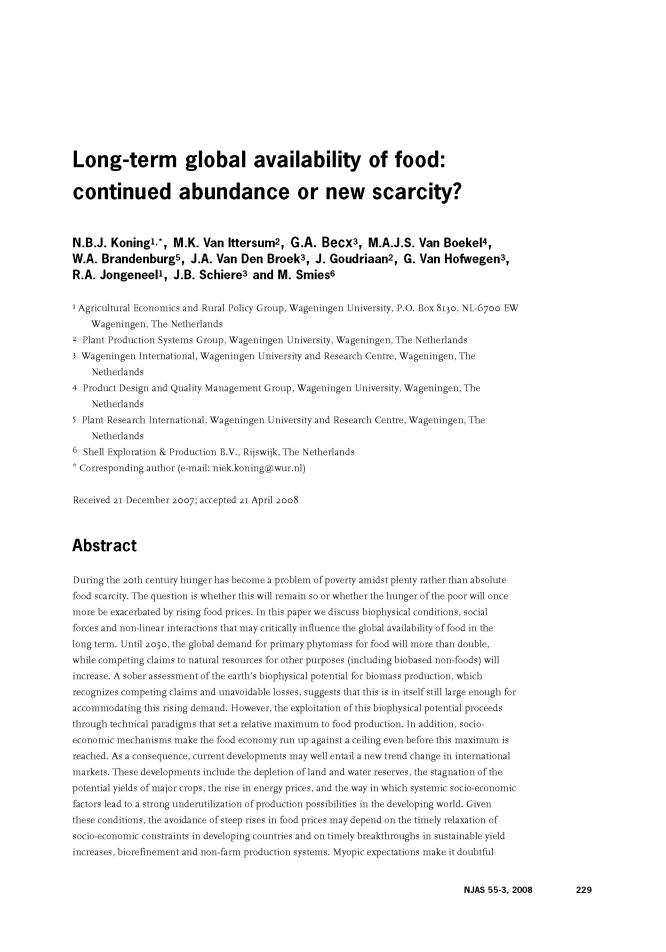Details
Location
Contributions
Displaying 731 - 740 of 2403Global biomass production potentials exceed expected future demand without the need for cropland expansion
Global biomass demand is expected to roughly double between 2005 and 2050. Current studies suggest that agricultural intensification through optimally managed crops on today's cropland alone is insufficient to satisfy future demand. In practice though, improving crop growth management through better technology and knowledge almost inevitably goes along with (1) improving farm management with increased cropping intensity and more annual harvests where feasible and (2) an economically more efficient spatial allocation of crops which maximizes farmers' profit.
Nature Communications
Nature Communications is an open access journal that publishes high-quality research from all areas of the natural sciences. Papers published by the journal represent important advances of significance to specialists within each field.
Aims & Scope
More on the aims and scope of Nature Communications is available in this section, as well as article and journal metrics, indexing and archiving information.
Long-term global availability of food: continued abundance or new scarcity?
During the 20th century hunger has become a problem of poverty amidst plenty rather than absolute food scarcity. The question is whether this will remain so or whether the hunger of the poor will once more be exacerbated by rising food prices. In this paper we discuss biophysical conditions, social forces and non-linear interactions that may critically influence the global availability of food in the long term.
Can Tanzania feed itself by 2050?: Estimating cereal self-sufficiency to 2050
Producing adequate food to meet global demand by 2050 is widely recognized as a major challenge, particularly for Africa south of the Sahara, including Tanzania (Godfray et al. 2010; Alexandratos and Bruinsma 2012; van Ittersum et al. 2016). Increased price volatility of major food crops (Koning et al. 2008; Lagi et al. 2011) and an abrupt surge in land area devoted to crop production in recent years (Grassini et al. 2013) reflect the powerful forces underpinning this challenge.
Global Food Policy Reports 2011
The 2011 Global Food Policy Report is a new annual IFPRI publication that provides a comprehensive, research-based analysis of major food policy challenges at the global, regional, national, and local levels. It highlights important developments and events in food policy that occurred in 2011, discusses lessons learned, offers policy recommendations, presents IFPRI’s food policy tools and indicators, and takes a look forward into 2012. The Report reflects perspectives from across the globe.
Food Security: The Challenge of Feeding 9 Billion People
Continuing population and consumption growth will mean that the global demand for food will increase for at least another 40 years. Growing competition for land, water, and energy, in addition to the overexploitation of fisheries, will affect our ability to produce food, as will the urgent requirement to reduce the impact of the food system on the environment. The effects of climate change are a further threat. But the world can produce more food and can ensure that it is used more efficiently and equitably.
Science
Science has been at the center of important scientific discovery since its founding in 1880—with seed money from Thomas Edison. Today, Science continues to publish the very best in research across the sciences, with articles that consistently rank among the most cited in the world. In the last half century alone, Science published:
- The entire human genome for the first time
- Never-before seen images of the Martian surface
The State of Food Insecurity in the World 2015
This year´s annual State of Food Insecurity in the World report takes stock of progress made towards achieving the internationally established Millennium Development Goal (MDG1) and World Food Summit hunger targets and reflects on what needs to be done, as we transition to the new post-2015 Sustainable Development Agenda. The report reviews progress made since 1990 for every country and region as well as for the world as a whole.
From Agriculture to Nutrition: Pathways, Synergies and Outcomes
In a world of food abundance, millions of people suffer from poor nutrition. In some parts of the world, the poor have inadequate access to energy from food to meet their energy requirements. In these locations, food shortage is often a seasonal phenomenon and micronutrients are also generally lacking in the diet. Elsewhere, there is a stable supply of energy but the poor have monotonous diets lacking in essential micronutrients.











